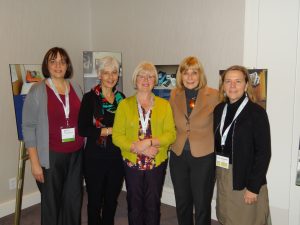The research team recently presented at the Qualitative Health Research Conference in Vancouver. Our symposium focused on creative approaches to knowledge translation, and involved three presentations: Arts-based, performative KT with sensitive topics; Expanding access and audience through digital and video production; and Lessons learned: Practical strategies for creative KT activities.
Overview:
Chair: Anita Molzahn
In this symposium we will share: a) challenges faced when working with dyads and the sensitive topic of death and dying in narrative inquiry; b) experiences with two forms of video production; and c) the lessons learned from a range of creative, arts-based and digital knowledge translation approaches. We draw from two consecutive narrative inquiries in which we explored the uncertainty of living with life-limiting chronic illnesses (advanced cancer, chronic obstructive pulmonary disease, end-stage kidney disease, heart failure, and HIV). In the first study we explored patient perspectives of living with a fatal chronic condition, and expanded in the second study to include the uncertainties of living-and-dying with dyads of patients and family caregivers. The two longitudinal studies involved 32 and 83 participants (32 dyads) respectively. We sought depth and richness by interviewing participants multiple times over one to three years. Our knowledge dissemination strategies were varied and creative in nature.
Abstract 1: Arts-based, performative KT with sensitive topics
Anne Bruce, Kara Schick-Makaroff, Anita Molzahn
Through this presentation, we will discuss how we focused knowledge translation (KT) strategies towards specific audiences through performance presentations, art exhibits, found poetry, and booklets. These included patients and families, policy-makers, educators, students and practitioners. In using creative approaches to address the sensitive topic of death and dying, there were potential pitfalls and unforeseen outcomes. Since we did not always know our audiences’ background and experiences, our team was attentive to how the KT activities would be received and (mis)understood. Some clinicians voiced apprehension about sharing resources about death and dying with patients that may be too direct or too explicit. These unexpected responses opened opportunities for further analysis and KT
development. An additional challenge arose with family and caregiver data collection (conducted separately) that impacted KT. Our second narrative study included family member (dyadic) interviews, where people living with a chronic illness and their family member were asked to share experiences of uncertainty through photographs. Although we aimed to keep these images separate and confidential, the dyads often shared their images with each other. However, during separate individual interviews, participants often shared stories about the images that were private, including experiences they may not have shared with their dyadic partner. This posed ethical and methodological challenges when linking images
Abstract 2: Expanding access and audience through digital and video production
Laurene Sheilds, Marcy Antonio, Kara Schick-Makaroff
In Canada, the knowledge translation (KT) process is most commonly described in terms of the Knowledge to Action Framework developed by Graham et al. (2006). The framework outlines a step-wise process for knowledge synthesis, but this does not necessarily reflect our experience with narrative KT. Through this presentation, we will introduce two different approaches we used in developing videos for knowledge mobilization and how these activities were part of our emergent qualitative design. We will discuss how our process for creating videos integrated back into our narrative analytic approach, and the key decisions we made during video production.
In our first study, video production followed a documentary format, where individual participants were contacted after formal data collection to see if they would like their stories shared through an audio recording. The videos represented participants’ actual voices and incorporated professionally taken photographs that were connected to what participants had shared. The second format involved developing a script from key messages the team identified within our narrative data. The script brought together multiple participants’ experiences, relied on editing by the video production team to create continuity and interest, and was communicated by professional actors. Through video excerpts, we will demonstrate how selecting videos as a KT activity requires consideration of the implications of a) working with a production team; b) embodying participants’ words through their own voice or with actors; c) adhering to current preferences for short video segments; d) representing the multilayered aspects of people’s lives; and e) integrating analysis within the knowledge synthesis process.
Abstract 3: Lessons learned: Practical strategies for creative KT activities
Marcy Antonio, Kara Schick-Makaroff, Robyn Wiebe
Although creative dissemination of qualitative findings is laudable, the process and complexity of these strategies raise important considerations. Negotiating how to integrate what is expected from digital and artistic productions versus research findings is a key consideration. We will explore analytic, creative and institutional differences we have encountered in generating KT that evocatively engage an audience, honour participants’ narratives, and adhere to university/ethics/funding requirements. We will discuss how we worked with media consultants and art curators in addressing the tension between staying close to the data and providing “creative license” to maximize artistic impact.
This was most poignant when the deeply personal photos that participants shared that were so critical to our analysis, were found not to provide the “quality” required for digital media. The development of our web site was also not straightforward; the institutional requirements for fitting with “the brand” lead us to search for other online formats where we would have more flexibility as to how we could present our data. Additionally, with a restricted time frame imposed by funding agency requirements, we found ourselves juggling the demands of in depth analysis with KT activities. Through this presentation, we describe these and other examples of how to plan for creative KT activities, budget for a range of resource-intense approaches, work with art curators, or media consultants, and ways of matching data with different KT forms.

